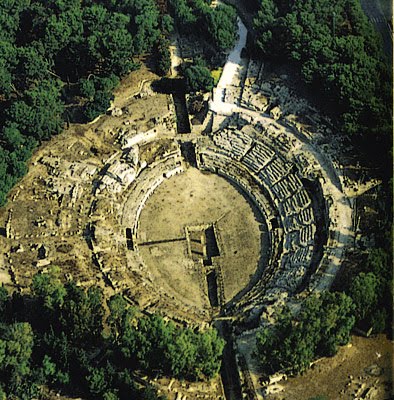It is the third world's largest Roman amphiteatre in the world, after the Coliseum and The Arena of Verona. Probably dating drom III century b.C. , excavated in the rock except for the south side, nowadays it has the upper level completely missing. The large blocks of which it was made up have been removed from the Spaniards in the sixteenth century for the construction of the walls of the island of Ortigia.
The size of the theatre, elliptical in shape, are remarkable: 140 meters long and 90 meters wide. Under the arena (70 meters and 40 meters), closed by a high podiium, there is a corridor called "crypta", from which the gladiators and the wild animals came out. Above the podium there were the steps where the most important citizens were seated and in fact we stilll have the namesof some local personalities carved in the marble.
Higher that these steps was the lower cavea, the only one which still remains, while the middle one and the higher one can be only imagined looking at the foundations that are still there.
In the center of the arena is still visible an underground passage, about 2,50 mters deep, where all the machines for the shows were placed, as can be seen in other amphiteatres of the same size.
Along the avenue which leads to the Amphitheatre it is possible to see some stone sarcophages, found in the necropolis of Siracusa and Megara Hyblea.
Address:Via del Teatro GrecoTimetables Archaological Park:
Every day from h.9.00 to two hours before the sunset (winter h.15.00, summer h.18.00).
Price: Only Archaological Park
Ticket € 10,00
UE citizens* Under 25 € 5,00
UE students**, under 18 e over 60 y.o free entrance
Groups and teachers free entrance
Combined Ticket Archaological Park + Archaological Museum Paolo Orsi
€ 13,50 (reduced € 7)
*only UE citizens and citizens of some other countries such as Australia, New Zealand, Mexico, Brazil, Japan, Canada, Chile, Argentina and few others. Passport needed ** only students from UE and from above listed non EU countries of archaeology literature, philosophy, arts, architecture. Student's card and passport needed.

